If you are thinking about adopting a pet turtle, you may be wondering what size tank do you need? How do you set it up? What makes a good tank?
Turtles need a properly sized tank that is well-lit, heated, filtered and clean. It is important to provide them with the best aquarium possible to keep them healthy and happy.
There is a lot of conflicting information about turtle tanks. So we made a complete guide covering: buying, setting up, and maintaining one.
Continue reading for reviews, setup tips and beginner mistakes.
Tetra 55-Gallon Turtle Aquarium Kit
Tetra is a trusted brand by fish and reptile enthusiasts across the globe. This tank is perfect for a single turtle and has all the elements for a fantastic turtle setup.
See Price on Amazon
All About Turtle Tanks
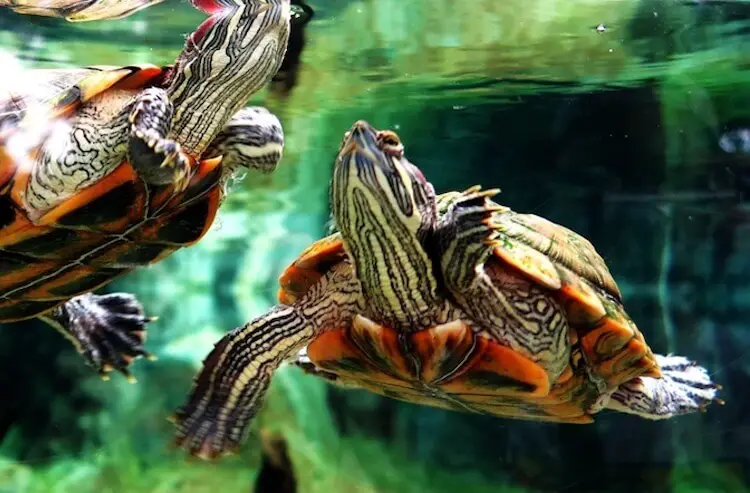 Many pet turtles (e.g. painted turtles, sliders, and map turtles) are semi-aquatic. This means they need an area for swimming and a land area for basking and resting.
Many pet turtles (e.g. painted turtles, sliders, and map turtles) are semi-aquatic. This means they need an area for swimming and a land area for basking and resting.
For turtles who love to swim their tank must be:
- Waterproof.
- Deep enough for your turtle to submerge and swim.
- Strong enough to hold 55 gallons of water.
- Be a top-open enclosure to stop water from leaking out.
Land loving species that do not swim (e.g. box turtles) can live in a front-open aquarium.
Fish tanks and purpose-built reptile tanks are suitable for keeping turtles, as long as they are fitted with lights, filtration, and have enough land area.
A turtle tank can be glass or acrylic. The material will normally depend on your budget and preference. Acrylic is lighter than glass, but it is more expensive and easier to damage. Glass is heavier, sturdier, cheaper and more widely available.
Any tank should have a screen top or no top (if the sides are high enough to prevent escapes). This will let air circulate and it also maximizes heat and light exposure for basking, though it will also increase the rate of evaporation.
Tanks are generally the most expensive part of an enclosure. It is a good idea to pick a sturdy, functional, and appropriately sized one from the start.
What Size Tank Do I Need For A Turtle?
Turtles are active reptiles and need a lot of space. Pet turtles normally need a tank size of 55 to 100-gallons depending on their species. A good rule of thumb is to buy a tank that has 10 gallons for every inch of your turtle’s shell length.
Some pet turtle can grow over 10 inches long and so will need tanks over 100-gallons:
| Turtle Species | Tank Size |
|---|---|
| Map | 80-gallon |
| Painted | 55-gallon |
| Box | 70-gallon |
| Yellow Bellied Slider | 100-gallon |
Male map turtles reach no more than seven inches, while females can grow to ten inches. An 80-gallon tank is a good choice.
Painted species are one of the smaller species of turtle and only grow to five or six inches. A 55-gallon tank will work for single, mid-sized painted individuals.
Box Turtles are terrestrial so do not need a swimming area. Also, they only grow to a maximum of seven inches. They can live happily in a 70-gallon aquarium that is longer than it is tall.
Aivituvin Wooden Box Turtle Habitat
If you are looking for a wooden terrarium for a land-based turtle, look no further. This tank is made with solid wood and holds up well to weathering, either indoor or outdoor.
See Price on Amazon
Both yellow-bellied and red eared sliders can grow to 12 inches long. Most get to 10 inches, so they’ll need at least a 100-gallon tank.
Turtles can be kept in all-female groups, though it is generally best to keep them on their own.
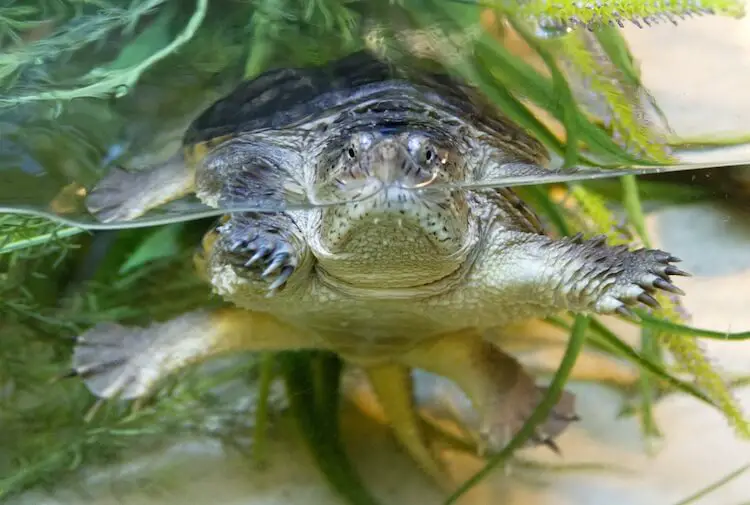
What Size Tank Do I Need For 2 Turtles?
The rule of 10 gallons per inch of shell only works for one turtle. For each turtle added to an enclosure, increase the tank’s surface area by at least another square foot. For example, one 7-inch spotted turtle can live in a 40.5” x 32” x 24” tank. Two should be kept in at least a 52.5” x 44” x 24”. In general, bigger is better.
They will happily use as much space as you give them.
Smaller aquariums limit the range of natural behaviors your pet can express. They also become dirtier faster which leads to a higher risk of stress and illness.
Best Turtle Tanks
| Editor’s Picks | Tank | Our Rating |
|---|---|---|
| Best Overall | SC Aquariums 150-Gallon Turtle Tank | 5 |
| Best for Beginners | Tetra 55-Gallon Turtle Aquarium Kit | 4.7 |
| Runner-Up | Landen Rimless 60-Gallon Turtle Tank | 4.5 |
Best for Beginners: Tetra 55-Gallon Turtle Aquarium Kit
Tetra 55-Gallon Turtle Aquarium Kit
Tetra is a trusted brand by fish and reptile enthusiasts across the globe. This tank is perfect for a single turtle and has all the elements for a fantastic turtle setup.
See Price on Amazon
This Tetra 55-Gallon Turtle Aquarium Kit is a glass tank that is solid and heavy. It will not warp over time and is resistant to scratching. As a standard rectangular aquarium, it is not seamless, but the glass is clear enough that seeing the corners is not a major drawback.
One of the best features is its double hinged top. This allows you to clean, reach your turtle, or replace food and water without having to open or remove the entire top. You can also place lights on one side of the tank and keep the other side closed to minimize evaporation.
Along with the tank, this kit comes with a 200-watt heater, a thermometer, pump, and water conditioners.
Except for the pump (which is too weak for a turtle) all the other extras are excellent additions to any turtle setup.
Pros:
- Comes with all the extra equipment to get started.
- Double hinged hood lets you open one side at a time.
- Glass is strong and will not scratch or warp.
- Editor’s choice for best beginner tank.
Cons:
- Heavier than acrylic.
- The included pump is not strong enough for a turtle.
Best Overall Tank: SC Aquariums 150-Gallon Turtle Tank
SC Aquariums 150-Gallon Turtle Tank
Your turtle will love the size of this tank! The SC Aquarium is strong, attractive, and well built. It is a good size for any large turtle, but would also work great for 2-3 members of a smaller species like bog or spotted turtles.
See Price on Amazon
This SC Aquariums 150-Gallon Turtle Tank is a fantastic model that measures 60” x 24” x 24”.
It is built with 12 millimeter thick glass for durability. Although thick, the glass is clear and we had no complaints about its ease of cleaning or aesthetic quality.
We highly recommend this tank for reptile owners who want to provide their turtles with a spacious enclosure for diving, swimming, and basking.
There is also a built-in overflow box and plumbing for an aquarium pump. This extra room is perfect for creating a more complex setup.
This aquarium has an open top which is perfect for a turtle setup. It lets you easily hang lights and heaters above the tank.
The back is covered with a black vinyl sheet. This is a nice, minimalistic backdrop. Alternatively, it can easily be removed and replaced as it isn’t glued. Some owners prefer all four sides clear.
Pros:
- Huge tank that is perfect for one large turtle or several smaller species.
- Built-in overflow box and plumbing for connection to an aquarium pump.
- Strong, attractive design with thick 12mm glass.
Cons:
- Very heavy both empty and filled so it needs a very strong stand.
- Overflow box and plumbing may be confusing for first time keepers.
Runner-Up: Landen Rimless 60-Gallon Turtle Tank
Landen Rimless 60-Gallon Turtle Tank
If you want a sleek and sturdy turtle tank, you will love this aquarium! At 60-gallons it is suitable for most adult turtles and sliders.
See Price on Amazon
This Landen Rimless 60-Gallon Turtle Tank has a seamless design with four clear, 10 millimeter glass walls.
The enclosure measures 35.4” x 19.7” x 19.7” but seems much larger due to its lack of visible seams. The corners line up perfectly with each other and bring out décor in the aquarium. The depth of this tank provides plenty of room for substrate and plants.
Because this tank requires you to set up all the equipment yourself, some people may not its simplicity. But, we found it provides a solid base to get creative with.
The glass holds up well against a turtle’s scratching and is highly resistant to gouges or nicks. The clarity of the glass is the best out of all the tanks we reviewed.
Pros:
- Extremely clear glass on all sides and no visible seams.
- Thick sides are resistant to scratching, gouges or nicks.
- A great size for most adult turtle species.
Cons:
- Does not come with any equipment (e.g. top or stand).
Equipment List
Turtles need proper lighting, heating and filtration. Any equipment installed in their tank should be functioning properly before adding your turtle. For a tank that is already cycled, or a terrestrial enclosure, wait three days after installing the equipment before adding your turtle.
Turtles require:
- UVB light.
- Full spectrum basking light.
- Floating islands, bridges or a land area.
- Aquarium heater.
- Aquarium pump and filter.
To properly grow and strengthen their shells turtles need to metabolize lots of calcium. This is similar to most pet reptiles (leopard geckos are a good example).
Turtles that have access to a UVB light have higher levels of vitamin D in their blood. Vitamin D helps to absorb calcium. Because of this, they are less likely to develop shell infections and metabolic bone disease. As most UVB bulbs do not put off much heat a basking bulb is also needed.
Basking bulbs are high-powered light bulb that provide a “hot spot” for basking.
Aquatic turtles will spend most of their time swimming. But, they do come out of the water to rest, eat and bask. Most turtles will bask for several hours each day to keep their body temperature of 82°F.
Since they cannot bask in the water, you will need to add “floating islands”, bridges or a land area in the tank. This land area should be positioned under both light bulbs and large enough for you turtle to fully come out of the water.
Just as turtles need warm air temperatures, they also need warm water temperatures.
Basking bulbs are great for heating air, but not water. You will need an aquarium heater too.
The aquarium heater should be strong enough to keep your turtle’s swimming water between 78-82°F. Heaters must also be secured to the side or bottom of the tank to prevent them from being dislodged by a swimming turtle.
Finally, turtles create a lot of waste for their size.
You will need a powerful aquarium pump and filter to clean and circulate water.
Turtles are messier than most fish. We recommend using a filter that is at least twice the size of your turtle’s tank. A 100-gallon filter is a good choice for a 50-gallon tank.
Setup Ideas
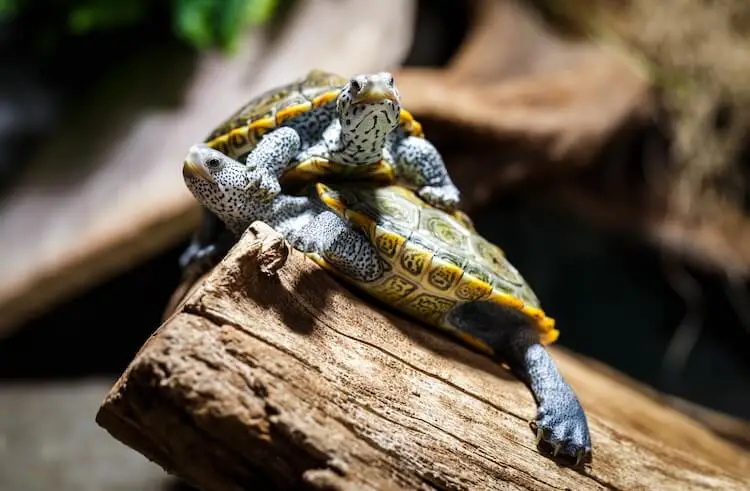 Now that you have an idea of the size, equipment and tank style, you can start thinking about décor. This is the most fun and flexible part of preparing a turtle tank. There are so many ways to do it!
Now that you have an idea of the size, equipment and tank style, you can start thinking about décor. This is the most fun and flexible part of preparing a turtle tank. There are so many ways to do it!
If you are looking for setup ideas, check out ours below. Slider Setup Sliders, like most species of turtles, need deep water to swim. Rocks or gravel can be used as a substrate, though many owners prefer to use no substrate for easier cleaning.
Aquatic plants can still be used in pots, though they may be chewed on. Java ferns, anubias, and anacharis are great additions that add a natural flair to the enclosure.
The terrestrial part of their tank is not as important as the water section. The land section can be cork, driftwood or a plastic turtle island. Box Turtle Setup While most pet turtles are aquatic, box turtles are not. They do not need to swim and are happy with a wide, shallow water bowl.
Making a natural-looking box turtle setup is simple.
Organic topsoil and leaf litter are excellent substrates (provided anything taken from outdoors is sterilized).
Non-toxic houseplants like hostas, ferns, and spider plants mimic a turtle’s native forest environment. Finally, use hollow logs, woven branches, or baskets to create hiding spaces.
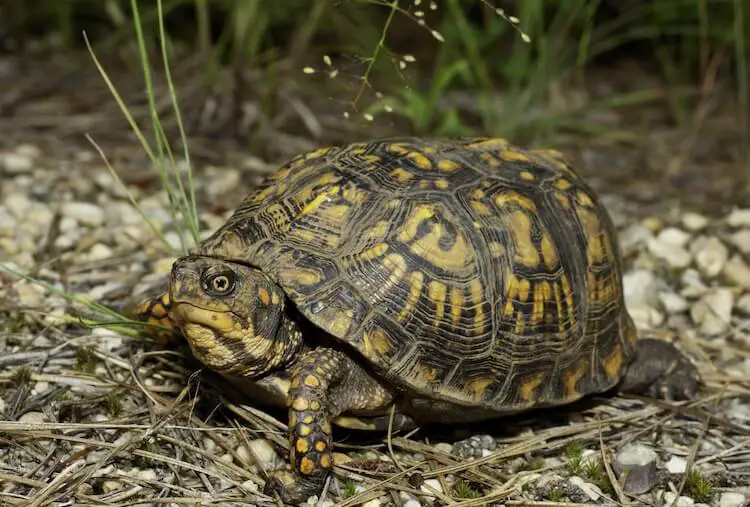
How To Set Up A Turtle Tank
- If you are using any underwater décor or substrate, add this first.
- Fill the tank with tap water deep enough water level to allow diving. This should be about twice as deep as the shell is long.
- Use a fish-friendly dechlorinate to remove chlorine and chloramines from tap water after filling.
- Add the equipment: floating island, aquarium heater, and pump and filter.
- After the pump and heater are up and running, the next step is to cycle the tank (see guide below).
- While the water is cycling, install the lights and basking bulb.
- Monitor the air and water temperatures and ensure they remain consistently within target temperatures.
- After your tank is cycled, add your turtle.
- Observe them carefully for the first few days to monitor for any health problems.
Tank Cycling
Cycling is a process where bacteria break down toxic ammonia from a turtle’s waste. This ammonia is turned into nitrite and then nitrate, which is much less toxic.
To start cycling, add a small amount of turtle food to the water. You will need to use an aquarium testing kit to monitor the levels of ammonia, nitrates, and nitrites in the tank once a day.
After a few days to two weeks, you should see a big spike in ammonia levels, followed by a spike in nitrates. This is a sign that the bacteria are beginning to grow in the filter and break down the waste. After a period of several weeks, the ammonia and nitrate levels should decrease to zero.
Once your tank is cycled it should remain below the following targets for five days:
- Ammonia should be at 0 parts per million.
- Nitrites below 0.5 parts per million.
- Nitrates below 40 parts per million.
Cycling a large enclosure takes time and patience, but it is necessary for the health of your reptile.
How To Clean A Turtle Tank
A common myth with turtle aquariums is that you do not need to clean them if you use an aquarium filter. This is false! A filter will help to keep the water clean from day to day, but they still need to be cleaned.
Cloudy water is a sign of a dirty tank. Dirty tanks can introduce harmful bacteria to your turtle. This not only bad for their health, but it also increases the risk of salmonella transmission between your pet and you.
Doing regular water changes, removing uneaten food, and using a powerful pump will keep a turtle’s water clear.
Once you get into the habit of cleaning your turtle’s tank, you will find that it is easy. Each Day Remove any uneaten food, empty and refill the water bowl (if applicable) and scoop out any visible waste. Each Week Replace 25% of your aquatic turtle’s water with tap water treated with a water conditioner. This is also a good time to test ammonia and nitrite levels in the water. Each Month Deep clean you turtle’s tank. This is a more involved process that involves cleaning everything in the aquarium and replacing the pump filter.
Do not rinse the filter media with fresh water or soap, as this will kill off the beneficial bacteria. If you are using a strong enough pump, you should only need to fully replace the filter every 3-4 months.
Take out all rocks and décor and wash them with white vinegar or a 1:10 solution of bleach and water.
Common Problems
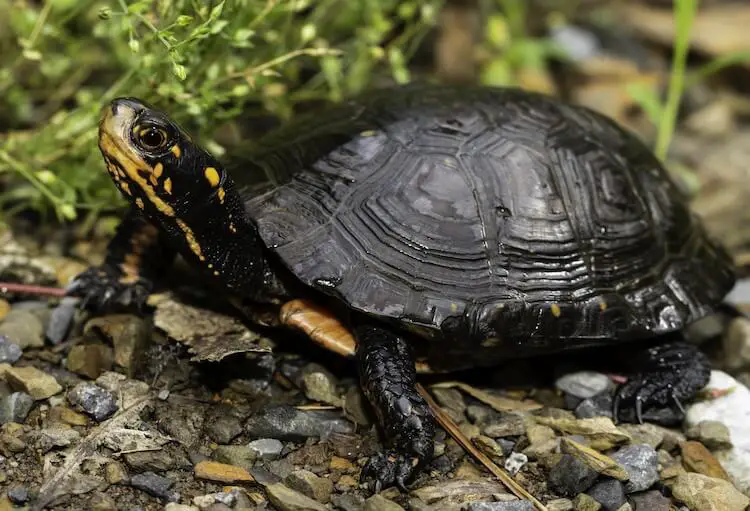 The three most widespread problems with turtle tanks are:
The three most widespread problems with turtle tanks are:
- Using an aquarium that is too small.
- Not cleaning regularly.
- Using a reptile terrarium not meant for turtles.
Turtles need more space than other similarly sized pet snakes or lizards. The bigger the tank, the healthier they will be. Remember to provide at least 10 gallons of water per inch of turtle shell.
Just as a small tank accumulates waste quickly, not cleaning it will cause a build-up of toxic ammonia and nitrites, even if the tank is cycled properly.
A dirty tank will have cloudy water and a film developing on the surface.
Finally, some first-time owners assume that all reptile tanks are suitable. This may be true for some terrestrial species, but most need an enclosure that can hold water.
Many reptile terrariums are too small for adult species and are also not completely watertight. This is why most turtle owners prefer to house them in fish tanks. Can Turtles Be Kept In A Fish Tank? Yes, turtles can be kept in a fish tank.
A fish tank is a great choice, provided it has all the necessary heating, lighting, and basking elements.
Keep in mind that aquatic turtles are omnivores and will eat most fish they live with. Is It Okay To Put Gravel In A Turtle Tank? Putting gravel in a turtle comes with a risk. Some individuals may accidentally ingest gravel while feeding or swimming, which can cause a blockage in their gastrointestinal tract.
If you do use gravel, use pieces that are too large to fit in their mouth.
Summary
Turtles make excellent and fun pets for anyone who is willing to put in the work to care for them.
Keeping a turtle is a rewarding experience, but they need a large tank.
They should have a tank that is 10 gallons per inch of shell length. You will need to add an extra 1-square-foot of surface area per extra individual added. With enclosures, it is better to go bigger than smaller.
Aquatic species especially are messy pets. Their tanks will need regular cleaning.
You will need to perform weekly partial water changes as well as a monthly deep-clean of the entire aquarium. To help keep the water clear, cycle the water prior to adding your turtle and invest in a powerful filter. Ready to set up your own turtle tank? Let us know in the comments!

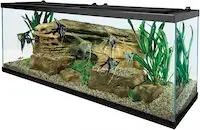
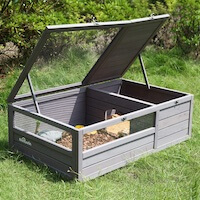
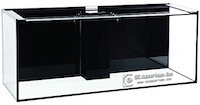
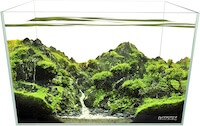
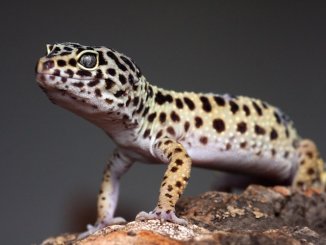
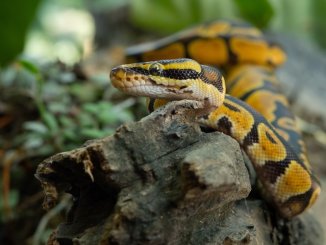
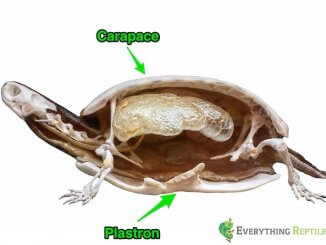

GREAT article!! I have a Central American Ornate Wood Turtle and he lives actually in a tortoise house with woodchips substrate and a small pool.
What size is a powerful pump /filter?
I would assume a filter the size of your water size . I have a 55 gallon tank & its a lil over half full of water . According to their standards I would use a filter 20-30 gallon
But one thing I know from my five fish tanks .ITS ALWAY BETTER TO HAVE A BIGGER FILTER rather a smaller filter
Just like the tank , bigger is going to be needed so plan on that & your filter can be bigger , you’ll use it on a bigger tank later . I use regular fish water conditioner
I have we a 75 gallon I think I will up him in that one day down the line with a 100 gallon filter or more
For filter fiber, I buy the white pillow filler , poly- fil• 4.00 for a big bag at Walmart in Arts n Crafts dept.
Just like a fish tank
If your using a 55 g tank & its half filled with water go with a 30 gallon filter or more